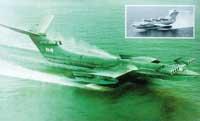Flying boats
Elhuyar Fundazioa
These flying ships, with their wings, engines and tail, made the greatest advances in this new form of transport in the former Soviet Union, although now also in the West have a great interest in this issue.

The Russians call them "ekranoplanes" and the Americans "wigs." In principle, these planes (or boats) can only go a few meters above the surface, but their main advantage is that when they circulate at a speed of 500 km/h, they consume 40% less fuel than conventional appliances. The reason for this is the effect of soil adhesion. This effect allows to take advantage of the forward thrust caused by the swirls that occur between the south of these vehicles and the underlying flat surface (sea or desert).
The effect of adhesion to the land was first seen in some birds, since on the sea the wings remained unshaken days, but pilots who travel by plane also know it because they feel it when taking off and landing. When the plane is near the ground, the aerodynamic resistance is lower. The upward thrust of conventional aircraft is due to the speed difference between the air above and below the wing (the bottom is flat). In the aerodynamic wing profile, the air has to circulate further from the top to the bottom, so the speed is also higher.
However, when the speed increases according to a fluid mechanics principle, the pressure decreases. Therefore, at the top there is a depression that "absorbs" the south upwards. In turn, at the bottom the overpressure "pushes" the south up. The combination of these two phenomena makes the plane have ascending force. But even though the plane remains high, it must be said that it also suffers aerodynamic resistance, which causes a decrease in speed.
The resistance arises because the air rubs the south and the profile of the plane. In the background there are swirls that stop the plane. However, when it goes very close to the earth, there is not enough space to create turbulence and there is no aerodynamic resistance, since the air is compressed between the wing and the earth. The plane moves over the air mattress created by itself. Thanks to this there are no weight limits and you need less fuel to fly.

However, this type of aircraft hitting the earth can only circulate in flat areas, which is an obstacle, but it must be taken into account that deserts and oceans occupy three quarters of our planet. That is why it can be very interesting for some archipelagos like Asia and maritime salvage.
The Soviet Union most investigated these special ships during the Cold War. They formed a fleet of Ecranoplano, with the aim of dominating the sea. Between 1960 and the early 1980s the Soviets produced more spectacular models than the Soviets. One of the most famous was the Caspian Monster. It was 100 meters long and circulated 20 meters above the surface. Despite weighing 544 tons of weight, with the thrust of eight engines achieved a speed of 550 km/h. An immense brand, because today the large Boeing 747 civilian aircraft weighs only 394 tons and only measures 70 meters. In addition, the Soviets had a 5,000 ton ecranoplane project that circulated at 900 km/h, but the Caspian Monster was destroyed in an accident in 1980 and the Soviet Union was destroyed, so the project suspended.

Today the flying ships have resurrection. The Australian city of Sydney annually holds a congress of experts from around the world. Australians have presented two prototypes. They are aircraft attached to the sea for use as a taxi. They can transport 8-17 people at a maximum speed of 180 km/h. However, Russian prototypes are the most advanced. A research office in Nijni-Novorod is awaiting funding to develop an ecranoplane of maritime use for salvage. They call it Spasatel and when a boat sinks it can work very quickly. It can reach a speed of 550 km/h, rest in the sea in waves four meters high and absorb up to 500 survivors. At present it is not possible to obtain such brands by boat and plane.
However, all these projects are faced with great administrative difficulty. What are they? Ships or planes? Separation is very important. In fact, the approval of the plane with which eight passengers travel costs more than three billion pesetas (120 million pounds), while the approval of the vessel of the same level is limited to fifteen million (600,000 pounds). Some, however, require international agencies to classify these vehicles in a special section, for their specific characteristics.





